ACID BASE BALANCE UG latest.pptx
- 2. We shall discuss ÔÇó Introduction to acids and bases ÔÇó Henderson-Hasselbalch equation ÔÇó Buffers ÔÇó Mechanisms of acid-base balance (Renal mechanism only briefly)
- 3. pH ÔÇó Potential/Power of hydrogen. ÔÇó S├©rensen introduced the concept of pH to measure the acidity and alkalinity of the solution. ÔÇó Is a negative logarithm of [H+]. pH = 1/ log[H+] = -log[H+] ÔÇó Ranges from 0 to 14. ÔÇó pH 7 is considered neutral. S├©rensen (1868-1939) Danish Chemist
- 5. Acids and Bases ÔÇó Various concepts. ÔÇó Useful for us: - Arrhenius acids and bases - Bronsted-Lowry acids and bases Svante Arrhenius (1859-19270 Swedish Scientist Originally physicist, later chemist/physical chemist
- 6. ARRHENIUS Theory of Acids and Bases Acids are the compound containing hydrogen that upon addition of water, yields H+ ions. e.g. HNO3 H+ + NO3 - Bases are compounds which upon ionization in water yields OH- ions. e.g. NaOH Na+ + OH- BRONSTED- LOWRY Theory of Acids and Bases Acid is a proton donor. Base is a proton acceptor In case of acids, ArrheniusÔÇÖ theory and this one is similar. The concept of base, however, is much broader. What is an alkali??
- 7. Strong Acids/Bases and Weak Acids/Bases ÔÇó Strong acids/bases dissociate completely. ÔÇó Weak acid/base dissociates partially. ÔÇó e.g. HCl is a strong acid, whereas CH3COOH is a weak acid in aquesous solution. ÔÇó e.g. NaOH is a strong base, whereas NH4OH is a weak base in water.
- 8. Conjugate Acids and Bases: ÔÇó The ionization product of an acid also produces ions or molecules other than H+ ions. ÔÇó These ions are able to combine with H+ ions, and hence are bases. ÔÇó They are called conjugate bases. ÔÇó Cl- is thus conjugate base of HCl; NO3 - is conjugate base of HNO3. ÔÇó Likewise for conjugate acids. If an acid is strong, its conjugate base is weak, & vice versa. If a base is weak, its conjugate acid is strong, & vice versa.
- 9. Dissociation constant ÔÇó LetÔÇÖs consider ionization of a weak acid HA. ÔÇó ItÔÇÖs dissociation constant, Ka, is given by: ÔÇó ka is constant for the given molecule. ÔÇó Negative logarithm of Ka is called pKa. Larger Ka means, more H+ can be dissociated. Hence, larger the Ka, stronger the acid and vice versa. pKa = 1/log Ka = -logKa
- 10. One example: Dissociation of acetic acid ÔÇó ItÔÇÖs Ka is given by: ÔÇó ItÔÇÖs pKa is given by: -logKa = 4.76 (a constant)
- 11. Can you derive this equation?? Henderson- Hasselbalch Equation Lawrence Joseph Henderson (1878-1942) American Physiologist, Chemist, & Biochemist Karl Albert Hasselbalch (1874-1962) Danish Physician & Chemist
- 12. Other forms of Henderson-Hasselbalch equation e.g. If CH3COOH dissociates to Ch3COO- and H+, CH3COO- can combine with Na+ to form a salt CH3COONa. Then, pH = pKa + log [salt] / [Acid] Similarly, pH = pKa+ log [salt]/[Base]
- 13. New (& more commonly used) definition of pKa When dissociated [A-]= undissociated [HA], then pH = pKa. Therefore: pKa is that pH where half of the acid (or ions) exist in dissociated form.
- 14. Example of acetic acid again ÔÇó At pH 4.76, half of the CH3COOH is dissociated to CH3COO- and H+ i.e. ([CH3COOH]= [CH3COO-]). ÔÇó Below 4.76 (i.e. pH < pKa), acetic acid does not dissociate much, - i.e. [CH3COOH]> [CH3COO-]. ÔÇó Above 4.76 (i.e. pH > pKa), more than half of acetic acid is dissociated, - i.e. [CH3COOH]< [CH3COO-]. pKa = 4.76
- 15. Acid base balance ÔÇó Why is maintaining Acid base balance so important to life?
- 16. ÔÇó Cellular & other functions depend on the correct structural & functional organizations of proteins & other biomolecules. ÔÇó This is dependent on pH & temperature at which they work optimally. ÔÇó Any variations might be fatal. Importance of Acid-base balance CONTÔÇÖD ´üÂFor normal functioning of the body, pH of body fluids has to be maintained within a narrow range. ´üÂDepartures from the normal range can cause serious consequences.
- 17. Production of acids is a physiological process ÔÇó Carbonic acids (aerobic glycolysis), lactic acids (anaerobic glycolysis), sulfuric acid, phosphoric acid (sulfo- and phospho-proteins), keto acids etc are produced on regular basis. ´âÿVolatile acids i.e. Carbonic acid is produced around 20,000 meq/day. ´âÿFixed (non-volatile) acids like lactic and sulfuric acids are produced around 80 meq/day]. No wonder our urine is acidic (except for pure vegan diet where production of alkali overwhelms acid production)
- 18. ÔÇó Since, acids and bases are constantly formed during metabolic reactions (+ also enter from outside), AND ÔÇó In some pathological conditions, there may be abnormal losses of acids or bases from the body. ÔÇó So, there should be a system to address these issues. To meet these challenges, elaborate mechanisms have evolved to maintain the acid-base balance of the body fluids Importance of Acid-base balance CONTÔÇÖD
- 19. Major Acid-base regulatory mechanisms 1. Buffers 2. Respiratory Mechanism 3. Renal Mechanism Acts Instantly But not a permanent solution Takes minutes to hours to kick in Very powerful against volatile acids Several hours to days The permanent fixer 1st line of defense
- 20. BUFFERS ÔÇó Solutions which can resist changes in pH by addition of acid or alkali. Buffer Solution Acid added Base added No Change in pH
- 21. Buffers are made up of Weak acid + Conjugate base (salt of conjugate base) Or, Vice versa. For example: ´ü▒Weak acid = CH3COOH ´ü▒Conjugate base = CH3COO- ´ü▒Salt of Conjugate base = CH3COONa Therefore, CH3COOH + CH3COO- or, CH3COOH + CH3COONa = BUFFER
- 22. Some buffers that we use in laboratory (to maintain pH) ÔÇó Glycine buffer ÔÇó EDTA buffer ÔÇó Tris Buffer ÔÇó etc. Note: Buffer are highly efficient around their pKa values. e.g. PKa of Tris buffer = 8. Therefore, its buffering range will be: 7.5-8.5 (or, 7-9) Typically: Buffer efficiency = pKa ┬▒1
- 23. A. Bicarbonate buffer B. Phosphate buffer C. Protein buffers D. Hemoglobin buffer Physiological buffers present in our body to maintain acid-base balance Major Buffer System
- 24. BICARBONATE BUFFER ´üÂWeak acid: H2CO3 ´üÂSalt of conjugate base: NaHCO3 ÔÇó pKa of carbonic acid is 6.1. ÔÇó So, the ideal buffering capacity would be around 5.1 to 7.1. ÔÇó pH of blood to be maintained: 7.35-7.45 - So, is bicarbonate buffer system useless to maintain pH? - No, in fact it is the most important buffer system in plasma/blood/ECF. How So?
- 25. pKa is not the only factor that determines buffering capacity... ÔÇó To illustrate this, letÔÇÖs have a look at Henderson- Hasselbalch equation again: ÔÇó In case of bicarbonate buffer: or Or, pH = 6.1 + log [NaHCO3]/[H2CO3] pH = pKa + log [NaHCO3] [H2CO3] pH = pKa + log [HCO3 -] [H2CO3]
- 26. ÔÇó Normal, [NaHCO3] in plasma= 27meq/L ÔÇó Normal, [H2CO3] in plasma = 1.35 meq/L ÔÇó Therefore,[NaHCO3]/ [H2CO3]= 20. ÔÇó LetÔÇÖs put this value in our earlier equation. pH = 6.1 + log 20 = 6.1 + 1.3 = 7.4. Bicarbonate buffer is therefore sometimes referred to as: Good physiological buffer ([Salt]/[Acid] = 20), AND Weak/Poor chemical buffer (pKa = 6.1) So, although the pKa value of bicarbonate buffer is not favorable to maintain the pH between 7.35 & 7.45, its high [Salt]/[Acid] concentration (= 20), more than compensates for it to act as a good ECF buffer.
- 27. Practical convention ÔÇó It is difficult to measure [H2CO3] in laboratory. ÔÇó But pCO2 can be easilymeasured. ÔÇó And it has been calculated that: [H2CO3]= 0.03 X pCO2 ÔÇó Therefore, we can write the Henderson-Hasselbalch equation for bicarbonate buffer as: We shall use this latter equation frequently. pH = pKa + [HCO3]/0.03 X pCO2
- 28. How does Bicarbonate Buffer resist change in pH? When strong acid (e.g. HCl) is added HCl  H+ + Cl  H+ + HCO3 -  H2CO3  H2O + CO2 H+ + HCO3 -  H2CO3 (weak acid) H2CO3 H2O & CO2.  Removed by expiration. When strong base (e.g. NaOH) is added NaOH  Na+ + OH- OH- + H2CO3 < === > HCO3 - + H2O Na+ + HCO3 - < === > NaHCO3 (weak base) Conjugate base part of the buffer (HCO3 -) neutralizes H+ Weak acid part of the buffer (H2CO3) neutralizes OH-
- 29. NEXT ÔÇó Phosphate & other buffers ÔÇó Respiratory mechanism ÔÇó Renal Mechanism (Brief)
- 30. PHOSPHATE BUFFER ´ü Weak Acid: NaH2Po4 ´ü Salt of Conjugate base: Na2HPO4 ÔÇó Buffer action mainly important intra-cellular. ÔÇó Also plays important role in buffering renal tubular fluid. ´âÿ pKa = 6.8 ´âÿ [Salt]/[Acid] = 4:1
- 31. Buffering Efficiency in ECF pKa = 6.8; [Salt]/[Acid] = 4:1 Therefore, pH = pKa + log [Salt]/[Acid] = 6.8 + log 4 = 6.8 + 0.6 = 7.4 So, it is still an efficient buffer despite low [salt]:[Acid] (compared to bicarbonate buffer) Phosphate Buffer is sometimes called as: Good Chemical Buffer (pKa = 6.8), AND Poor Physiological Buffer ([Salt]:[Acid] = 4)
- 32. Point to note: In fact, Phosphate buffer is efficient across even wider pH range ÔÇó Phosphate buffer has 3 PKa values, as it has 3 dissociable H+ ions. One of these pKa value (6.8) and [Salt]:[Acid] is suitable for it to act as biological buffer HÔéâPOÔéä HÔü║ + HÔééPOÔéä┬» pKÔéÉ = 1.96 HÔééPOÔéä┬» HÔü║ + HPOÔéä┬» ┬» pKÔéÉ = 6.8 HPOÔéä┬» ┬» HÔü║ + PO Ôéä┬░ pKÔéÉ = 12.4
- 33. How phosphate buffer resists change in pH When strong acid (e.g. HCl) is added HCl Ôåö H+ + Cl ÔÇô H+ + Na2HPO4 Ôåö Na+ + NaH2PO4(weak acid) Na+ + Cl- NaCl When strong base (e.g. NaOH) is added NaOH Ôåö Na+ + OH- OH- + NaH2PO4 <=>Na2HPO4 (weak base) + H+ H+ + OH- <=> H2O Conjugate base part of the buffer (Na2HPO4) neutralizes H+ Weak acid part of the buffer (NaH2Po4) neutralizes OH-
- 34. Assignment Write short note on Alkali Reserve
- 35. Protein Buffers ´ü Proteins are among the most plentiful buffers in the body because of their high concentrations, especially within the cells. ´üÂApproximately 60-70% of the total chemical buffering of the body fluids is inside the cells, and most of this results from the intracellular proteins. [In addition to the high concentration of proteins in the cells, another factor that contributes to their buffering power is the fact that the pKa of many of these protein systems are fairly close to 7.4]
- 36. ´üÂProteins act as buffers because of their amphoteric nature. ´üÂBuffering capacity of protein depends on the pKÔéÉ value of ionizable side chains. ´üÂThe amino acid residues having pKÔéÉ close to 7.4 are the most effective in buffering. ´üÂThe most effective group is histidine imidazole group. ´üÂProteins especially albumin, account for about 95% of the non-bicarbonate buffer value of plasma. [Each albumin contains 16 histidine residues which make it an effective buffer] Assignment: Name some important intracellular protein buffers
- 37. Hemoglobin Buffer ÔÇó Hemoglobin is responsible for 60% of the buffering capacity of blood. ÔÇó The large number of histidine (36) residues in Hb make it an effective buffer. Role of Hb will be discussed in detail in conjunction with respiratory mechanisms.
- 38. RESPIRATORY MECHANISM ÔÇó Responds within minutes. ÔÇó Rapid and powerful, especially against volatile acids. ÔÇó Blood pH is adjusted by changing the rate & depth of breathing. ÔÇó DoesnÔÇÖt fix non-volatile acids like lactic acid.
- 39. Something about respiratory centre ÔÇó Located in medulla oblongata & pons ÔÇó Increased pCOÔéé is the most important stimulant of the respiratory centre. - Increases the rate & depth of the respiration. - This increases the elimination of COÔéé. ÔÇó A fall in pH also stimulates the respiratory centre leading to hyperventillation & increased COÔéé elimination. ÔÇó Changes in pOÔéé affect the respiratory centre to a lesser extent (except marked anorexia e.g. at high altitude resulting in hyperventillation).
- 40. ACIDOSIS Respiratory center stimulated Hyperventillation CO2 exhaled pH returns to normal RESPIRATORY MECHANISM CONTÔÇÖD ALKALOSIS Respiratory center inhibited Hypoventillation CO2 retained pH returns to normal
- 41. ÔÇó Hb serves to transport the COÔéé formed in the tissues. ÔÇó Hb combines with HÔü║ ion and helps to transport COÔéé as HCOÔéâ┬» with minimum changes in pH which is referred to as ISOHYDRIC transport. ÔÇó Side by side, it serves to generate bicarbonate or alkali reserve by the activity of carbonic anhydrase (CA) system. ÔÇó We shall see how. Role of hemoglobin in Respiratory mechanism NOTE: Binding of H+ with Hb also helps to dissociate O2 from Hb, thus delivering oxygen to the tissues. See BohrÔÇÖs effect for detail.
- 42. COÔéé + HÔééO HÔééCOÔéâ HÔééCOÔéâ HÔü║ + HCOÔéâ┬» HÔü║ + Hb HHb
- 43. Chloride Shift ´üÂCarbonic anhydrase (CA) converts CO2 to H2CO3 in RBC. ´üÂH2CO3 dissociates to HCO3 - and H+. ´üÂWhile H+ is taken up by Hb to be carried into lungs, the HCO3 - produced in RBC enters plasma where it can serve as buffer. ´ü An equivalent anionic charge enters inside RBC (Cl-) to maintain the electrical neutrality. This exchange of bicarbonate and chloride in RBC (where bicarbonate exits and chloride enters RBC) is called Chloride shift.
- 44. HCO3 - produced in RBC is exchanged with Cl- in plasma. HCO3 - exits & Cl- enters RBC. Anion exchanger is the transport protein Chloride shift
- 45. Reverse Chloride shift ´ü The blood reaches the lungs. ´ü Here, bicarbonate enters RBC in exchange for chloride. (Reverse Chloride shift) ´ü▒ H+ dissociates from Hb (due to high pO2) ´ü▒Bicarbonate (HCO3-) combines with H+ to form H2CO3. ´ü▒ Carbonic anhydrase (CA) converts it to H2O and CO2. ´ü▒CO2 is exhaled.
- 46. Reverse Chloride shift HCO3 - enters & Cl- exits RBC.
- 47. Brief Summary of Chloride and Reverse chloride shift
- 48. Renal Mechanism of acid base balance ÔÇó Can eliminate large amounts of acid. ÔÇó Can also excrete base. ÔÇó Can conserve and produce bicarbonate ions. ÔÇó Most effective regulator of pH. If kidneys fail, pH balance fails
- 49. Details during Renal system 4 major ways by which the renal regulation operates : A. Excretion of HÔü║ (& production of bicarbonates) B. Reabsorption of bicarbonate C. Acidification of monohydrogen phosphate [May also be called: Excretion of titrable acid] D. Secretion of ammonia (NHÔéäÔü║ ions) 8
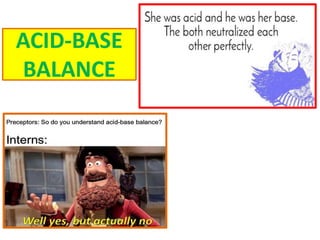
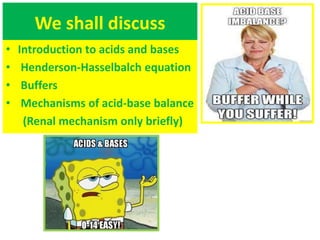
![pH
ÔÇó Potential/Power of hydrogen.
ÔÇó S├©rensen introduced the
concept of pH to measure the
acidity and alkalinity of the
solution.
ÔÇó Is a negative logarithm of [H+].
pH = 1/ log[H+] = -log[H+]
ÔÇó Ranges from 0 to 14.
ÔÇó pH 7 is considered neutral.
S├©rensen (1868-1939)
Danish Chemist](https://image.slidesharecdn.com/acidbasebalanceuglatest-230407075407-64771a7a/85/ACID-BASE-BALANCE-UG-latest-pptx-3-320.jpg)
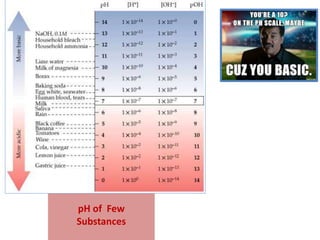
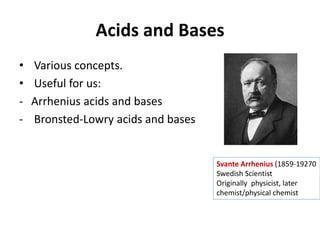
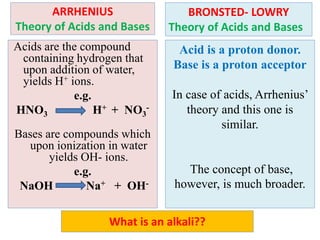
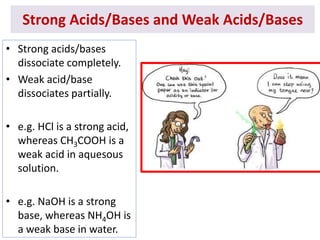
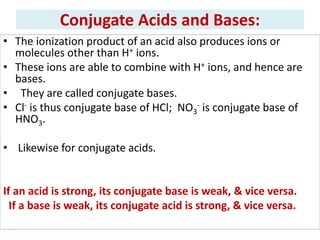
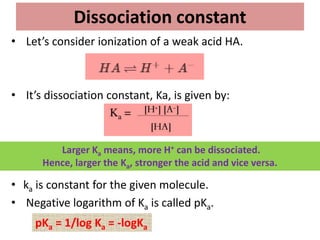
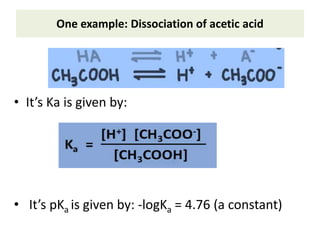

![Other forms of Henderson-Hasselbalch equation
e.g. If CH3COOH dissociates to
Ch3COO- and H+,
CH3COO- can combine with Na+ to
form a salt CH3COONa.
Then,
pH = pKa + log [salt] / [Acid]
Similarly,
pH = pKa+ log [salt]/[Base]](https://image.slidesharecdn.com/acidbasebalanceuglatest-230407075407-64771a7a/85/ACID-BASE-BALANCE-UG-latest-pptx-12-320.jpg)
![New (& more commonly used) definition of pKa
When dissociated [A-]= undissociated [HA],
then pH = pKa.
Therefore:
pKa is that pH where half of the acid (or
ions) exist in dissociated form.](https://image.slidesharecdn.com/acidbasebalanceuglatest-230407075407-64771a7a/85/ACID-BASE-BALANCE-UG-latest-pptx-13-320.jpg)
![Example of acetic acid again
ÔÇó At pH 4.76, half of the CH3COOH is
dissociated to CH3COO- and H+
i.e. ([CH3COOH]= [CH3COO-]).
ÔÇó Below 4.76 (i.e. pH < pKa), acetic
acid does not dissociate much,
- i.e. [CH3COOH]> [CH3COO-].
ÔÇó Above 4.76 (i.e. pH > pKa), more
than half of acetic acid is
dissociated,
- i.e. [CH3COOH]< [CH3COO-].
pKa = 4.76](https://image.slidesharecdn.com/acidbasebalanceuglatest-230407075407-64771a7a/85/ACID-BASE-BALANCE-UG-latest-pptx-14-320.jpg)
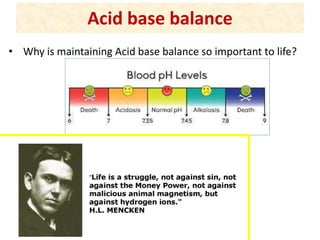
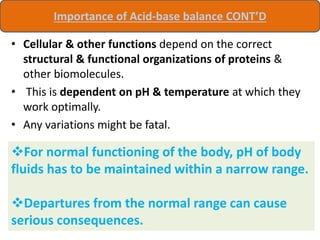
![Production of acids is a physiological process
ÔÇó Carbonic acids (aerobic
glycolysis), lactic acids
(anaerobic glycolysis), sulfuric
acid, phosphoric acid (sulfo-
and phospho-proteins), keto
acids etc are produced on
regular basis.
´âÿVolatile acids i.e.
Carbonic acid is produced
around 20,000 meq/day.
´âÿFixed (non-volatile) acids
like lactic and sulfuric
acids are produced around
80 meq/day].
No wonder our urine is acidic (except for pure
vegan diet where production of alkali
overwhelms acid production)](https://image.slidesharecdn.com/acidbasebalanceuglatest-230407075407-64771a7a/85/ACID-BASE-BALANCE-UG-latest-pptx-17-320.jpg)


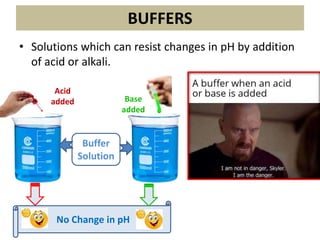
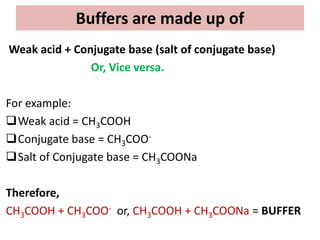

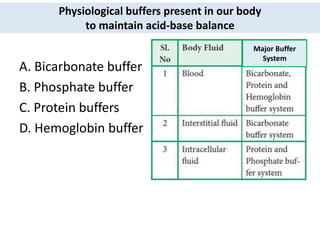
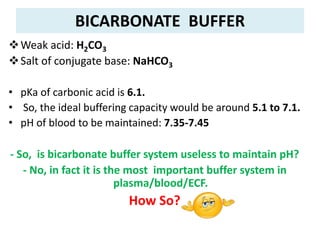
![pKa is not the only factor that determines buffering
capacity...
ÔÇó To illustrate this, letÔÇÖs have a look at Henderson-
Hasselbalch equation again:
ÔÇó In case of bicarbonate buffer:
or
Or, pH = 6.1 + log [NaHCO3]/[H2CO3]
pH = pKa + log [NaHCO3]
[H2CO3]
pH = pKa + log [HCO3
-]
[H2CO3]](https://image.slidesharecdn.com/acidbasebalanceuglatest-230407075407-64771a7a/85/ACID-BASE-BALANCE-UG-latest-pptx-25-320.jpg)
![ÔÇó Normal, [NaHCO3] in plasma= 27meq/L
ÔÇó Normal, [H2CO3] in plasma = 1.35 meq/L
ÔÇó Therefore,[NaHCO3]/ [H2CO3]= 20.
ÔÇó LetÔÇÖs put this value in our earlier equation.
pH = 6.1 + log 20
= 6.1 + 1.3
= 7.4.
Bicarbonate buffer is
therefore
sometimes
referred to as:
Good physiological
buffer
([Salt]/[Acid] = 20),
AND
Weak/Poor chemical
buffer
(pKa = 6.1)
So, although the pKa value of bicarbonate
buffer is not favorable to maintain the pH
between 7.35 & 7.45, its high [Salt]/[Acid]
concentration (= 20), more than
compensates for it to act as a good ECF
buffer.](https://image.slidesharecdn.com/acidbasebalanceuglatest-230407075407-64771a7a/85/ACID-BASE-BALANCE-UG-latest-pptx-26-320.jpg)
![Practical convention
ÔÇó It is difficult to measure [H2CO3] in laboratory.
ÔÇó But pCO2 can be easilymeasured.
ÔÇó And it has been calculated that:
[H2CO3]= 0.03 X pCO2
ÔÇó Therefore, we can write the Henderson-Hasselbalch
equation for bicarbonate buffer as:
We shall use this latter equation frequently.
pH = pKa + [HCO3]/0.03 X pCO2](https://image.slidesharecdn.com/acidbasebalanceuglatest-230407075407-64771a7a/85/ACID-BASE-BALANCE-UG-latest-pptx-27-320.jpg)
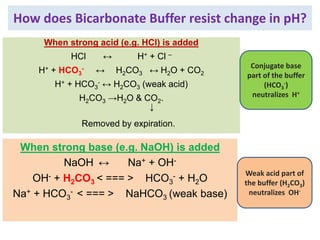

![PHOSPHATE BUFFER
´ü Weak Acid: NaH2Po4
´ü Salt of Conjugate base: Na2HPO4
ÔÇó Buffer action mainly important intra-cellular.
ÔÇó Also plays important role in buffering renal tubular fluid.
´âÿ pKa = 6.8
´âÿ [Salt]/[Acid] = 4:1](https://image.slidesharecdn.com/acidbasebalanceuglatest-230407075407-64771a7a/85/ACID-BASE-BALANCE-UG-latest-pptx-30-320.jpg)
![Buffering Efficiency in ECF
pKa = 6.8; [Salt]/[Acid] = 4:1
Therefore,
pH = pKa + log [Salt]/[Acid]
= 6.8 + log 4
= 6.8 + 0.6
= 7.4
So, it is still an efficient buffer
despite low [salt]:[Acid]
(compared to bicarbonate
buffer)
Phosphate Buffer is
sometimes called as:
Good Chemical Buffer
(pKa = 6.8),
AND
Poor Physiological Buffer
([Salt]:[Acid] = 4)](https://image.slidesharecdn.com/acidbasebalanceuglatest-230407075407-64771a7a/85/ACID-BASE-BALANCE-UG-latest-pptx-31-320.jpg)
![Point to note:
In fact, Phosphate buffer is efficient across even wider pH range
ÔÇó Phosphate buffer has 3 PKa values, as it has 3
dissociable H+ ions.
One of these pKa
value (6.8) and
[Salt]:[Acid] is
suitable for it to
act as biological
buffer
HÔéâPOÔéä HÔü║ + HÔééPOÔéä┬» pKÔéÉ = 1.96
HÔééPOÔéä┬» HÔü║ + HPOÔéä┬» ┬» pKÔéÉ = 6.8
HPOÔéä┬» ┬» HÔü║ + PO Ôéä┬░ pKÔéÉ = 12.4](https://image.slidesharecdn.com/acidbasebalanceuglatest-230407075407-64771a7a/85/ACID-BASE-BALANCE-UG-latest-pptx-32-320.jpg)
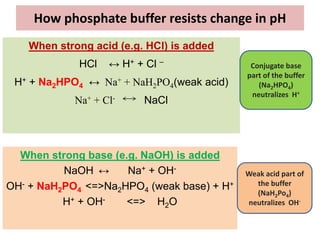

![Protein Buffers
´ü Proteins are among the most plentiful buffers in the
body because of their high concentrations, especially
within the cells.
´üÂApproximately 60-70% of the total chemical buffering
of the body fluids is inside the cells, and most of this
results from the intracellular proteins.
[In addition to the high concentration of proteins in the
cells, another factor that contributes to their buffering
power is the fact that the pKa of many of these protein
systems are fairly close to 7.4]](https://image.slidesharecdn.com/acidbasebalanceuglatest-230407075407-64771a7a/85/ACID-BASE-BALANCE-UG-latest-pptx-35-320.jpg)
![´üÂProteins act as buffers because of their
amphoteric nature.
´üÂBuffering capacity of protein depends on the
pK value of ionizable side chains.
´üÂThe amino acid residues having pKÔéÉ close to
7.4 are the most effective in buffering.
´üÂThe most effective group is histidine
imidazole group.
´üÂProteins especially albumin, account for
about 95% of the non-bicarbonate buffer
value of plasma.
[Each albumin contains 16 histidine residues
which make it an effective buffer]
Assignment:
Name some
important
intracellular
protein
buffers](https://image.slidesharecdn.com/acidbasebalanceuglatest-230407075407-64771a7a/85/ACID-BASE-BALANCE-UG-latest-pptx-36-320.jpg)
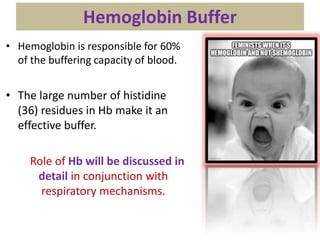
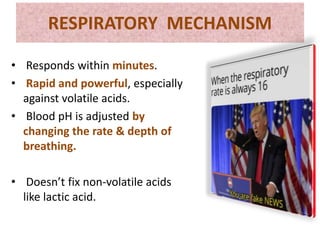
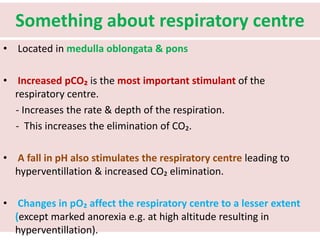

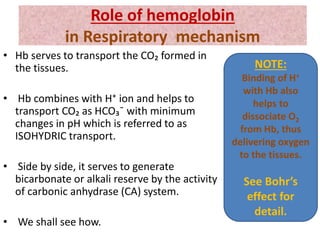
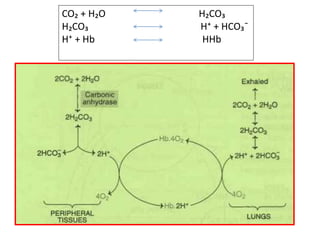
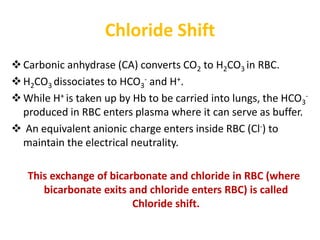



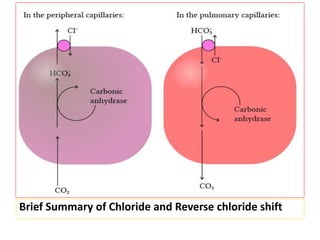
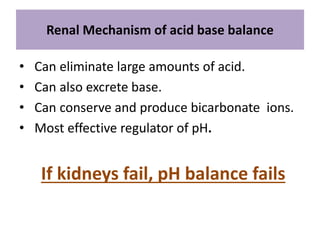
![Details during Renal system
4 major ways by which the renal regulation operates :
A. Excretion of HÔü║ (& production of bicarbonates)
B. Reabsorption of bicarbonate
C. Acidification of monohydrogen phosphate [May also
be called: Excretion of titrable acid]
D. Secretion of ammonia (NHÔéäÔü║ ions)
8](https://image.slidesharecdn.com/acidbasebalanceuglatest-230407075407-64771a7a/85/ACID-BASE-BALANCE-UG-latest-pptx-49-320.jpg)
